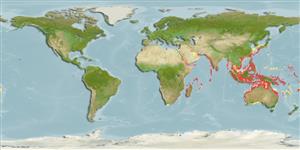Environment: milieu / climate zone / profondeur / distribution range
Écologie
marin; saumâtre récifal; profondeur 1 - 50 m (Ref. 90102). Tropical
Indo-Pacific: Red Sea (Ref. 33390) and East Africa to Papua New Guinea (Ref. 9710), north to southern Japan, south to Australia.
Taille / Poids / Âge
Maturité: Lm ? range ? - ? cm
Max length : 300 cm TL mâle / non sexé; (Ref. 9710)
Épines dorsales (Total) : 0; Rayons mous dorsaux (Total) : 0; Épines anales: 0; Rayons mous anaux: 0; Vertèbres: 138 - 144. Basically white with black blotches and interspaces forming a honeycomb pattern (Ref. 30404, 48635). Some individuals have a near black overall appearance (Ref. 48635). Blotches variable between individuals and size, often in relation to habitat - those in clear coral reefs usually have proportionally less black than those found in turbid waters (Ref. 30404).
Body shape (shape guide): eel-like; Cross section: compressed.
Inhabits reef flats and outer reef slopes of continental reefs (Ref. 9710). One of the two largest of Indo-Pacific morays. Often in holes with cleaner wrasses or shrimps (Ref. 48635). Feeds on cephalopods and small fishes (Ref. 30573). Large adults may be aggressive (Ref. 9710). Minimum depth reported taken from Ref. 30573.
Life cycle and mating behavior
Maturité | Reproduction | Frai | Œufs | Fécondité | Larves
Chen, H.-M., K.-T. Shao and C.T. Chen, 1994. A review of the muraenid eels (Family Muraenidae) from Taiwan with descriptions of twelve new records. Zool. Stud. 33(1):44-64. (Ref. 6934)
Statut dans la liste rouge de l'IUCN (Ref. 130435: Version 2025-1)
Menace pour l'homme
Reports of ciguatera poisoning (Ref. 4537)
Utilisations par l'homme
Pêcheries: intérêt commercial mineur; Aquarium: Aquariums publics
Outils
Articles particuliers
Télécharger en XML
Sources Internet
Estimates based on models
Preferred temperature (Réf.
123201): 24.5 - 29.1, mean 28.1 °C (based on 1258 cells).
Phylogenetic diversity index (Réf.
82804): PD
50 = 0.5000 [Uniqueness, from 0.5 = low to 2.0 = high].
Bayesian length-weight: a=0.00035 (0.00021 - 0.00058), b=3.27 (3.13 - 3.41), in cm total length, based on LWR estimates for this species & Genus-body shape (Ref.
93245).
Niveau trophique (Réf.
69278): 4.4 ±0.51 se; based on food items.
Résilience (Réf.
120179): Très faible, temps minimum de doublement de population supérieur à 14 ans (Preliminary K or Fecundity.).
Fishing Vulnerability (Ref.
59153): Very high vulnerability (90 of 100).
🛈
Nutrients (Ref.
124155): Calcium = 13.2 [6.2, 23.6] mg/100g; Iron = 0.323 [0.176, 0.697] mg/100g; Protein = 19.2 [16.9, 21.8] %; Omega3 = 0.0899 [, ] g/100g; Selenium = 59.6 [27.8, 126.1] μg/100g; VitaminA = 33.6 [8.2, 149.0] μg/100g; Zinc = 0.836 [0.553, 1.234] mg/100g (wet weight);
